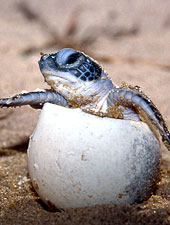<h2;font-size:300%;font-weight:bold;border:1px solid #CCCCFF;text-align:center;color:#000;padding:0.2em 0.4em;">Olive Ridley Turtle</h2>
Lepidochelys olivacea
Size
- Carapace length: 50 - 75 cm
Description
- The olive ridley turtle is the smallest of the marine turtles. The carapace of this turtle is olive coloured and relatively heart-shaped, whilst the undersurface is a greenish white.
Range
- Found in tropical regions of the Indian, Pacific and Atlantic Oceans, excluding the Caribbean. The largest nesting colonies occur in Mexico, Costa Rica and the Orissa coast, India
Habitat
- The olive ridley turtle inhabits tropical waters, and adults are known to be pelagic, feeding in the open ocean. Nesting tends to occur on mainland shores, on wide beaches that are often close to river or estuary mouths.
Biology

- Adult olive ridleys are carnivorous and feed on a wide variety of organisms including fish and molluscs. Very little is known about the first years of life but juveniles probably spend a number of years floating on the ocean currents and feeding on planktonic organisms.
- Although they do also nest alone, olive ridleys are known for their remarkable mass nestings, when many thousands of females congregate on the same beach; the event is known as an arribada, which is Spanish for mass arrival.
- Males and females migrate from the feeding grounds and mating occurs just offshore of the beach. Usually at night, and coinciding their nesting with the high tide, females haul out on their natal beach and lay clutches that typically contain around 110 to 120 eggs. These astonishing mass nestings can involve up to 150,000 females and there may be more than one arribada on a single beach; this overcrowding means that turtles are often crawling over each other to move up the beach and may even unearth other nests whilst digging their own.
- During one season a female may lay two to three clutches of eggs, returning to breed every few years. After around 50 to 60 days, the hatchlings emerge and make their journey to the sea. Predators such as jackals and crabs will feed on turtle eggs, whilst birds attack hatchlings on the beach and fish wait in the shallows. These arribadas probably function to increase hatchling survival by overwhelming predators with sheer numbers.
Threats
- Nesting in such large congregations, the olive ridley turtle is particularly vulnerable to human activities such as development and exploitation. This turtle has been extensively over-harvested for its eggs and meat.
- In Central and South America there is a massive market for the now illegal turtle eggs, which are traditionally believed to have aphrodisiac properties. One of the most important threats to the olive ridley is incidental catch (bycatch) by the fishing industry; turtles caught in trawl nets drown and are then discarded. Between 1993 and 1999, more than 50,000 dead turtles were found along the Orissa coast in India, primarily as a direct result of illegal fishing in the area.
Conservation
- International trade in olive ridley turtles and products is banned under their listing on Appendix I of the Convention on International Trade in Endangered Species (CITES) but a significant illegal trade (particularly in eggs) still occurs. *TRAFFIC (the wildlife trade monitoring arm of WWF and the IUCN) is involved in monitoring black market trade and bringing it to the attention of relevant authorities.
- The fitting of Turtle Excluding Devices (TEDs) to shrimp-trawl nets offers an encouraging step in their conservation; a 'trap-door' in the net allows the large turtles to escape. Their use is still not widespread however, and even in countries where the use of TED's is mandatory, this is not enforced.
- A number of major nesting beaches are protected and conservation projects work to artificially rear turtle eggs and then release them. Recently the number of olive ridleys nesting in Mexico has increased, and arribadas have returned to the Gahirmatha rookery in Orissa, India; perhaps offering a glimmer of hope that conservation efforts are working.
|